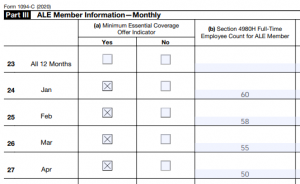Everything You Need to Know About Applying for the Employee Retention Credit (ERC) in 2021
February 23, 2021
You may not have heard of the Employee Retention Credit (ERC) until recently. If so, you’re not alone! That’s because businesses who applied for the Paycheck Protection Program (PPP) loan in 2020, weren’t eligible to apply for the ERC. In 2021 though that has all changed. Now businesses who applied for the PPP loan are eligible for the Employee Retention Credit both retrospectively and in 2021, which is HUGE! This news was released in December 2020 with the passing of the Consolidated Appropriations Act.
So, what does this all mean? What exactly is the Employee Retention Credit and how do you qualify to receive it? In this article we will break everything down for you so you have a good understanding of what it is and how you can get the most of your Employee Retention Credit!
First, what is the Employee Retention Credit?
In order to understand the Employee Retention Credit, we will take a time machine all the way back to March 2020 (don’t worry we will be sure to quickly come back to present day.)

In March of 2020, the U.S. Federal Government signed a $2 trillion relief act, known at the CARES Act, that aimed at providing relief to individuals, businesses, and government organizations. As a part of the CARES Act, if your business was hit hard due to the effects of COVID-19, you were eligible to apply for one of two incentives that would help businesses keep employees on staff during the pandemic. These incentives were known as the Paycheck Protection Program (PPP) and the Employee Retention Credit (ERC).
The PPP loan was the most notable of the two and it provided forgivable loans to businesses with fewer than 500 employees. If you applied for the PPP loan, then you were barred from applying for the Employee Retention Credit. The Employee Retention Credit was not limited by the number of employees and is a refundable payroll tax credit. The credit was available to tax payers who either had their business fully or partially suspended during a quarter in 2020 or had a drastic drop in gross receipts compared to quarters in 2019. If they qualified, they could receive a credit of up to $5,000 per employee that received a qualified wage.
Okay, that was a fun quick synopsis of where we came from. Now let’s get back to the future and talk about what has changed in the present day!
New Law Extends Opportunity to Claim the Employee Retention Credit
In December of 2020, a new relief law was passed, the Consolidated Appropriations Act. This act extends the Employee Retention Credit date and also changes who is eligible for it. Originally, the ERC date was supposed to end at the end of 2020, however, it is extended through June of 2021.

In addition to the extension date, the biggest eligibility change is everybody that borrowed a PPP loan can not only apply for the ERC in 2021, but can go back and apply for it in the 2020 year. YES, this can mean a great deal for businesses! The amount you received from the PPP loan, however, will be different than the ERC. The PPP loan has to be spent primarily on payroll, where the ERC is based on wages that qualify, including healthcare costs.
So, How Do You Qualify?
In order to be eligible for the Employee Retention Credit, businesses have to prove one of the below circumstances:
- That operations were fully or partially suspended due to government orders
- If you are applying for the credit in 2020, you need to show a 50% or greater decline in gross receipts from the same quarter a year prior. Or if you are applying for the credit in 2021, you need to show a 20% or greater decline in gross receipts from the same quarter in 2019
What Wages Qualify?
If you meet one of the above criteria, then the below wages will qualify for the time frame you are applying for:
From March 13th – December 31st 2020, if you have less than or equal to 100 full-time employees in 2019, all wages qualify. If you have more than 100 full-time employees in 2019, only wages for employees not providing services qualify.
From January 1st – June 30th, 2021, if you have less than or equal to 500 full-time employees in 2019, all wages qualify. If you have greater than 500 full-time employees in 2019, only wages for employees not providing services qualify.
*To determine how many full-time employees you had in 2019, use Form 1094-C. On page 2 in column B, enter the number of full-time employees you had in each month. Add the 12 numbers up and divide it by 12. That will give you the number of full-time employees you had in 2019.

How Much Credit Can You Receive?
For credits applied for between the March 13th – December 31st, 2020 range, a credit can be claimed up to 50% of the first $10,000 in total qualified wages paid and healthcare costs. This is equivalent to $5,000 per employee.
For credits applied for between January 1st – June 30th, 2021, a credit can be claimed up to 70% of the first $10,000 in total qualified wages paid and healthcare costs per quarter. This is equivalent to $7,000 per employee for each quarter.
How Do You Receive it and How Do You Submit it?

Okay, we just dove into A LOT of detailed information! Feel free to take a breather if you need one.
*DEEP BREATH*
Now onto the final stretch!
As you were reading the above, you may already have a bunch of numbers spinning in your head trying to figure out how much credit you might be able to receive. Once you sit down and put all of the numbers together, you will report your 2020 total qualified wages and related health insurance costs on the Adjusted Quarterly Federal Tax Return, Form 941-X. For 2021, you will report your total qualified wages and health insurance costs on the quarterly employment tax return on Form 941. Note, this form is currently in draft mode and cannot be used. The final 2021 form has not been released yet.
The credit will eventually be taken from your quarterly payroll tax bill against your employee portion of FICA. If your tax credits land up exceeding your tax bill, you will receive a check from the IRS.
Have Questions on Maximizing Your Credits?
Now you know the basics and if you are eligible to receive the ERC. It’s time to start the process of claiming your credits!
As you can see, figuring out the amount you are eligible for the Employee Retention Credit can be a tricky thing. If you are unsure about where to begin or have questions, work with your accountant or payroll specialist. Additionally, there are outside consultants that specialize in the maximization of tax credits. If you want to ensure you are getting the most out of your ERC, an outside specialist may be worth looking into.
Ready to talk to an expert today? Automated Business Designs has a new partnership with Tax Credit Co. (TCC), to help identify, calculate, and deliver the Employee Retention Credit for our clients. Reach out to info@abd.net if you are an ABD client that would like to learn more about ERC and have a conversation with TCC.

